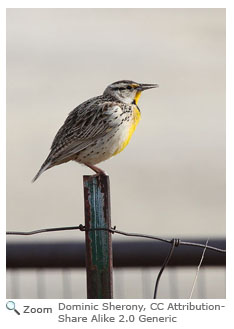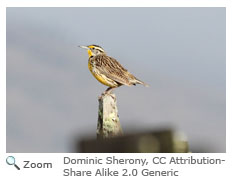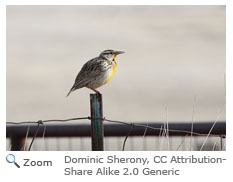Description
 The Eastern Meadowlark is built for camouflage. On the ground, its brown and black patterned wings and back blend in with surrounding dirt and dry grass. Up on perches, their bright yellow belly and chest stands out. The black mark across its chest is also distinctive. The Eastern Meadowlark is often seen perched on a fencepost or telephone line during the spring, singing its lazy song across grasslands and farms. The Eastern Meadowlark is built for camouflage. On the ground, its brown and black patterned wings and back blend in with surrounding dirt and dry grass. Up on perches, their bright yellow belly and chest stands out. The black mark across its chest is also distinctive. The Eastern Meadowlark is often seen perched on a fencepost or telephone line during the spring, singing its lazy song across grasslands and farms.
Range
Year round, the Eastern Meadowlark can be found throughout the eastern United States, including parts of Texas, Arizona and New Mexico. It is also found in Central America, the Caribbean and the northern tip of South America. During the summer, the Eastern Meadowlark breeds in the northeastern United States and southeastern Canada.
Habitat
 The Eastern Meadowlark inhabits wide open spaces like farm fields, grassland and wet fields. It prefers large areas of land but will live in grassy areas of at least six acres in which to establish a territory. The Eastern Meadowlark builds its nest on the ground and sings on perches such as treetops, fence posts and power lines. The Eastern Meadowlark inhabits wide open spaces like farm fields, grassland and wet fields. It prefers large areas of land but will live in grassy areas of at least six acres in which to establish a territory. The Eastern Meadowlark builds its nest on the ground and sings on perches such as treetops, fence posts and power lines. |
|
Diet
 An omnivore, the Eastern Meadowlark mostly eats insects such as crickets, grasshoppers, caterpillars and grubs. In the winter, it also eats seeds and wild fruit. To feed, the Eastern Meadowlark walks on the ground looking for food to grab with its sharp, pointed bill. An omnivore, the Eastern Meadowlark mostly eats insects such as crickets, grasshoppers, caterpillars and grubs. In the winter, it also eats seeds and wild fruit. To feed, the Eastern Meadowlark walks on the ground looking for food to grab with its sharp, pointed bill.
Life Cycle
 The female builds the nest by herself, taking about a week to complete. Using dead grasses, plants and bark, she builds the nest on the ground. Creative nest builders, some nests even have roofs and tunnels! The female lays 2-7 white, speckled eggs. Upon hatching, chicks have few feathers and closed eyes. Chicks begin to leave the nest after 10-12 days. The female builds the nest by herself, taking about a week to complete. Using dead grasses, plants and bark, she builds the nest on the ground. Creative nest builders, some nests even have roofs and tunnels! The female lays 2-7 white, speckled eggs. Upon hatching, chicks have few feathers and closed eyes. Chicks begin to leave the nest after 10-12 days.
As the Eastern Meadowlark builds its nest on the ground and needs a large grassy habitat in which to live, it is very sensitive to the disappearance of farmland. Conservation areas are critical to its survival.
Behavior
 The Eastern Meadowlark male can sing many versions of its song. In New York, a male was observed to sing over 100 different song patterns! The Eastern Meadowlark male can sing many versions of its song. In New York, a male was observed to sing over 100 different song patterns! |





